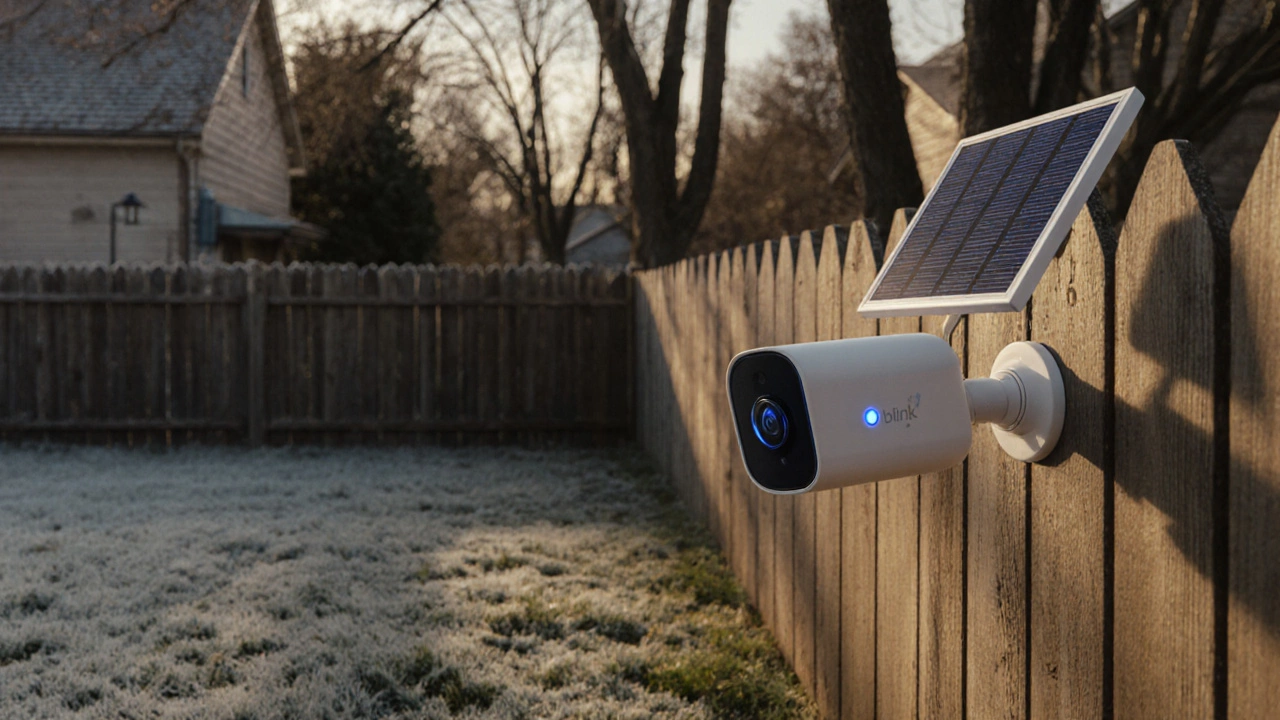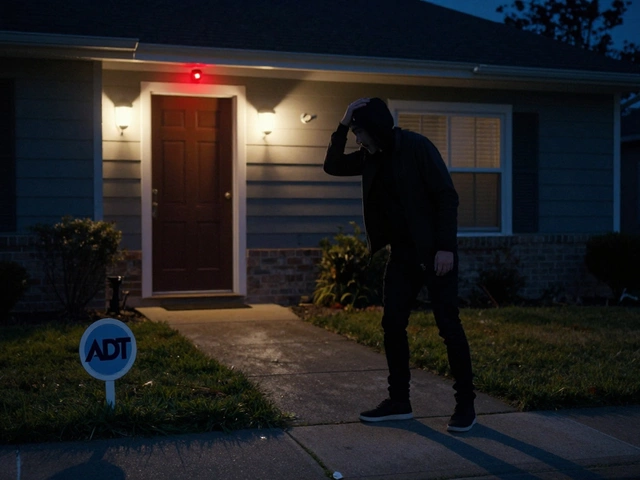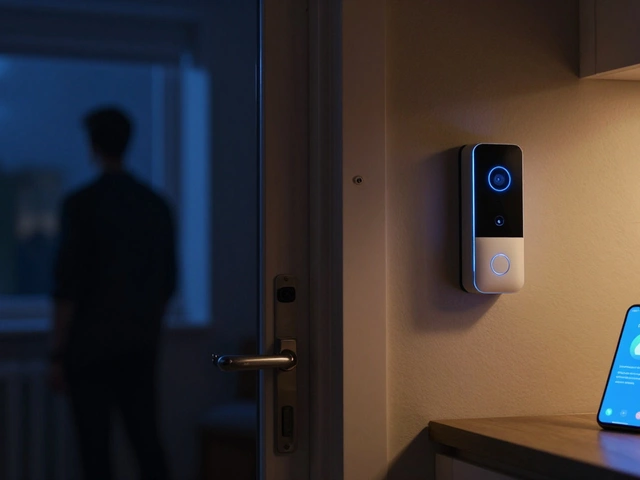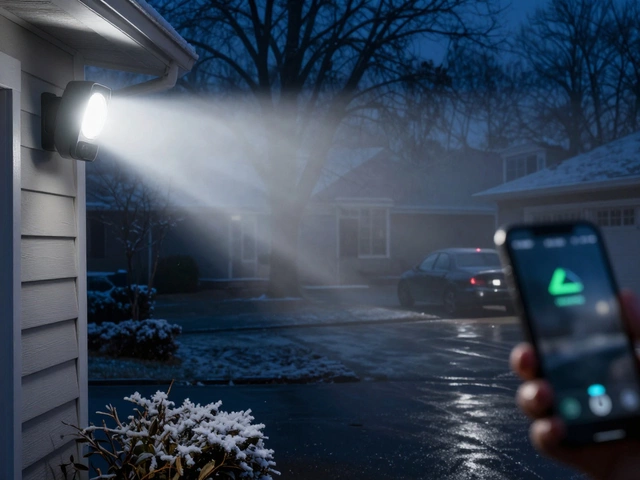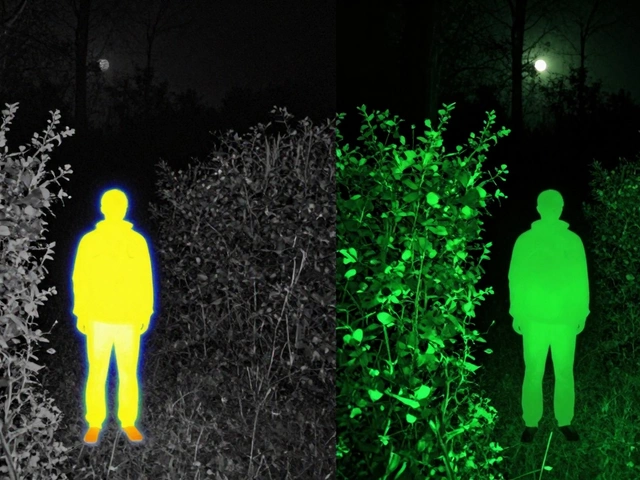Battery Camera Life Calculator
How Long Will Your Camera Last?
This calculator estimates real-world battery life based on actual usage conditions, not manufacturer lab tests. Your results will likely be 25-40% less than advertised claims.
Estimated Battery Life
Based on your settings, your battery camera will last approximately under these conditions.
When you buy a battery-powered security camera, the box says "up to 6 months" on the label. You feel good about it. Then, two months later, the app pings you: "Low battery." You didn’t even have the camera on live view much. What happened?
The truth is, most people get far less battery life than advertised. And it’s not because they’re doing anything wrong-it’s because manufacturers test their cameras under perfect conditions that don’t exist in real life.
What’s Really Behind the Numbers
Companies like Arlo, Ring, and Blink advertise battery life based on lab tests: 5 minutes of recording per day, mild temperatures, strong Wi-Fi, and no motion events outside normal hours. But real homes don’t work like that.
Take the Blink Outdoor 4. Amazon claims it lasts up to two years. That’s true-if you live in a quiet neighborhood with 10-15 motion events per day, no freezing winters, and your camera is within 30 feet of your router. But if you live near a busy street, have a dog that runs past the camera every morning, or you’re in Minnesota where it hits -15°C in January? That same camera might last 4-6 months.
Reconeyez says its camera lasts 400 days. Independent tests from Security.org found 320 days under ideal conditions. That’s still impressive-but drop the temperature below freezing, and you’re looking at 200 days max. The difference isn’t magic. It’s physics.
Lithium batteries lose up to 40% of their capacity when it’s colder than 0°C. That’s not a flaw. That’s how chemistry works. If you live in Sheffield, where winter temps regularly dip below freezing, your camera’s battery life is going to shrink-no matter what the ad says.
Brand Comparison: Who Actually Delivers
Not all battery cameras are built the same. Here’s what real-world testing shows:
| Model | Advertised Battery Life | Actual Average Life | Key Factor |
|---|---|---|---|
| Blink Outdoor 4 | Up to 24 months | 12-18 months | Low power sleep mode, efficient motion detection |
| Reolink Argus 3 Pro | Up to 6 months | 4-5 months | Solar charging option, good signal handling |
| Arlo Essential | 6-8 months | 3-4 months | Higher resolution (2K), more power drain |
| Ring Stick Up Cam Battery | 3-6 months | 2-3 months | Weak signal = high power use |
| Night Owl SPOTLIGHT-2CAM | Up to 1 year (4 batteries) | 8-10 months | Dual battery swap system |
| Reconeyez | Up to 400 days | 250-320 days | Advanced power management, but sensitive to cold |
The Blink Outdoor 4 wins for longevity because it doesn’t constantly stream or record. It sleeps. It wakes up only when motion is detected, and even then, it records for just 15-30 seconds. Most other cameras keep the camera sensor and processor running longer, draining the battery faster.
What Drains Your Battery the Fastest
It’s not the camera itself. It’s how you use it.
- Wi-Fi signal strength: If your camera is in the backyard and your router is in the front hall, it’s working overtime to stay connected. At 25% signal strength, it uses 37% more power than at 75%. Move it closer to your router, or get a Wi-Fi extender.
- Live view: Every minute you watch live feed drains the battery like a phone call. Just 15 minutes a day can cut battery life by 18%.
- Motion frequency: If your camera faces the driveway and your kids come and go 10 times a day, plus the mailman, plus the neighbor’s dog, you’re recording 60+ events. That’s not "moderate use." That’s heavy use. Cameras with 50+ motion events daily last 40% less time.
- Resolution: 2K video uses nearly twice the power of 1080p. If you don’t need to read license plates from 50 feet away, stick with 1080p.
- Temperature: Cold isn’t just uncomfortable-it kills battery life. If you live in a place with winters, expect to replace batteries more often.
One Reddit user in Minnesota said his Ring camera died every 2 months. He moved it 10 feet closer to his router, lowered the resolution, and turned off live view. Battery life jumped from 6 weeks to 5 months.
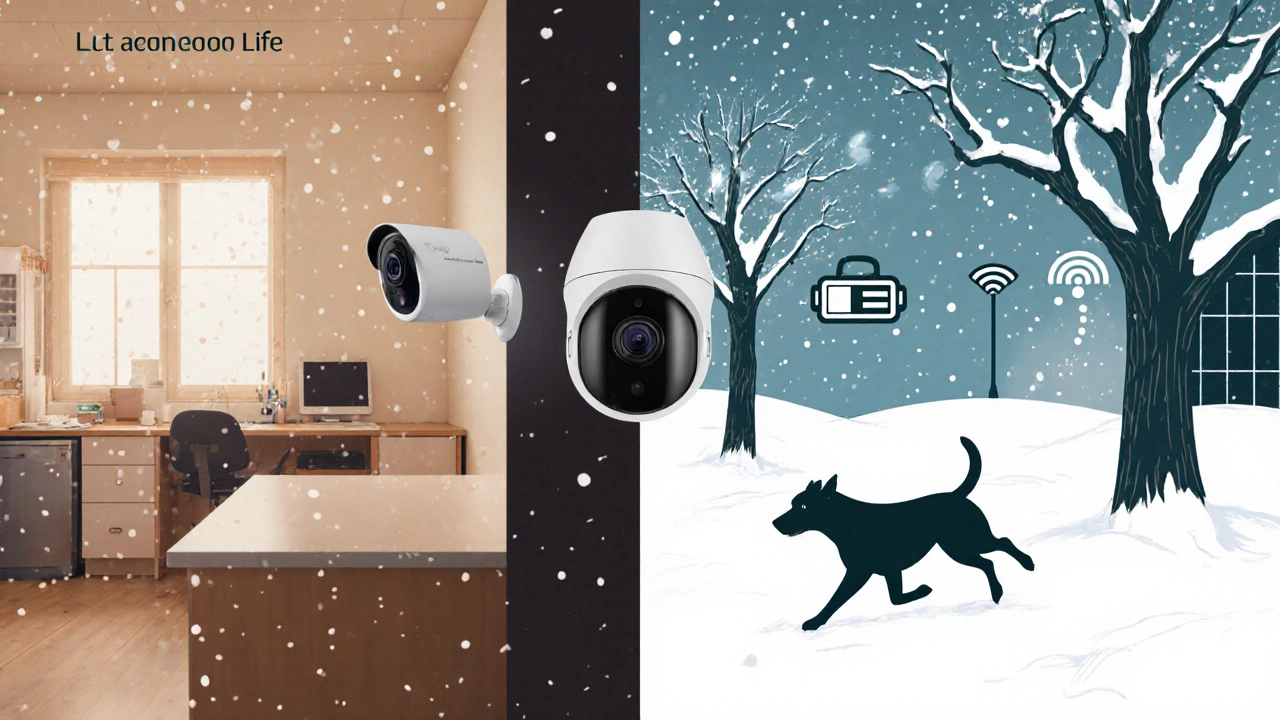
How to Make Your Battery Last Longer
You don’t need to buy a new camera. You just need to tweak how it’s set up.
- Position it right: Keep it within 30 feet of your Wi-Fi router. Avoid metal fences, thick walls, or large appliances between the camera and router.
- Lower the resolution: Switch from 2K to 1080p. You won’t miss much unless you’re monitoring a high-value area.
- Limit motion zones: If your camera sees a tree that sways in the wind, set the motion zone to ignore that area. Fewer false alerts = less recording = longer battery.
- Use solar charging: If your camera supports it, get a solar panel. Reolink says 10 minutes of sun = 24 hours of operation. In the UK, even a cloudy day gives you enough charge to make a difference.
- Turn off live view: Unless you’re checking in on your pet or baby, don’t use it. It’s a battery killer.
- Update firmware: Manufacturers often release updates that improve power efficiency. Check for them every few months.
Pro tip: If you’re installing multiple cameras, start with one. Watch its battery life for 4 weeks. Adjust settings. Then install the rest. You’ll save hours of troubleshooting later.
What About Battery Replacement?
Most battery-powered cameras use removable battery packs. Replacing them takes 3-5 minutes. But here’s the catch: batteries degrade.
After 18-24 months, even if the camera still works, the battery holds only 70-80% of its original charge. That means a camera that used to last 6 months now lasts 3. SafeHome.org’s 2025 survey found most users replace batteries every 2 years. Each replacement costs $30-$40.
Some models, like the MyQ Outdoor Camera, use magnetic battery connectors that snap on easily. Others require you to unscrew a panel. Check the design before you buy. If you’re planning to install 4 cameras, factor in $120-$160 in battery replacements every two years.
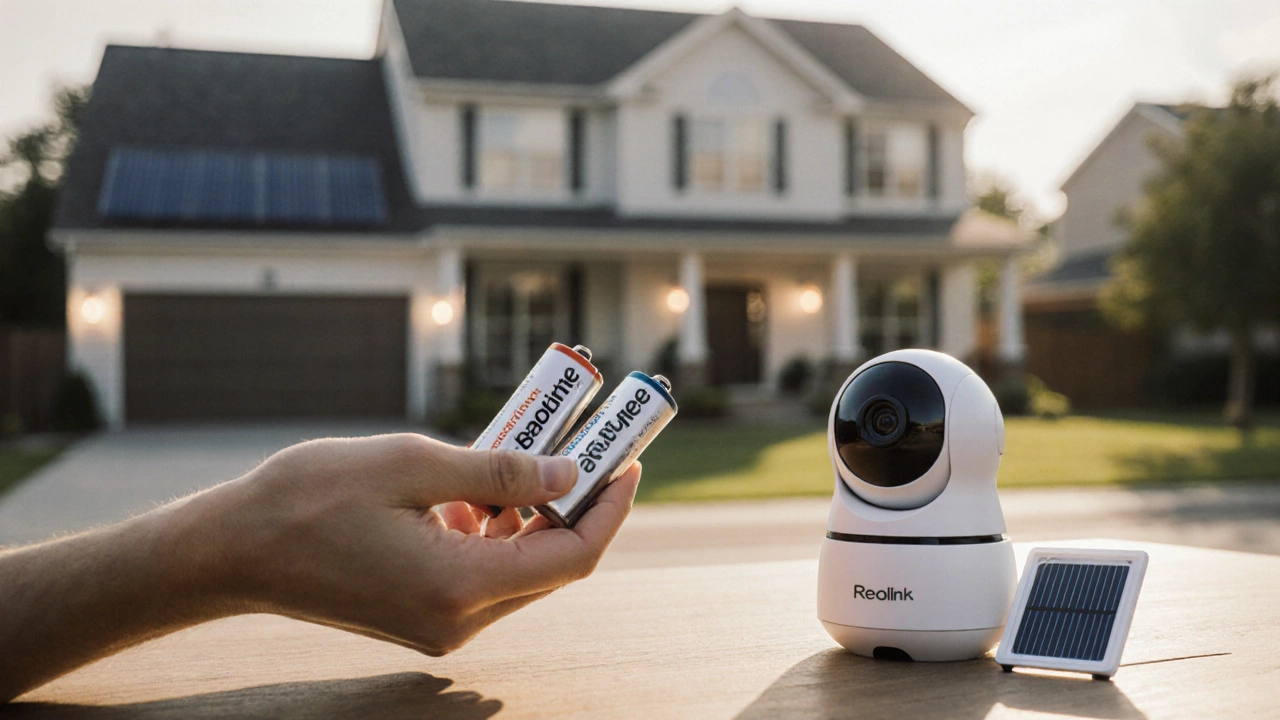
Solar Is the Real Game-Changer
Here’s the secret most people don’t talk about: solar panels turn battery cameras into almost maintenance-free devices.
Security.org’s 2025 survey showed that 82% of users who added solar charging extended their battery life by an average of 137%. That means a camera that used to last 4 months now lasts 9-10 months-even in winter.
Models like the Reolink Argus 3 Pro, Arlo Solar Panel Kit, and Eufy Solar-Powered Cam all work with standard solar chargers. You don’t need to buy the brand’s official panel-third-party ones often work just as well.
Place the solar panel where it gets direct sunlight for at least 4 hours a day. South-facing (in the Northern Hemisphere) is best. Even in Sheffield, where winter days are short, a small panel can keep your camera running through the season.
When Battery Cameras Just Won’t Cut It
Battery cameras are perfect for:
- Rental properties
- Backyards and side gates
- Temporary setups (like during construction)
- Remote cabins or sheds
They’re not ideal for:
- Front doors with constant foot traffic
- Commercial properties (like shops or warehouses)
- Areas with poor Wi-Fi
- Places where you need 24/7 recording
Pro-Vigil’s 2024 case study found that in retail stores, 67% of battery cameras needed weekly charging. That’s not practical. Wired cameras or PoE (Power over Ethernet) systems are better for those uses.
If you’re trying to monitor a busy driveway or a front porch where people ring the bell, a battery camera will drain fast. You’ll be changing batteries every month. That’s not security. That’s a chore.
Final Reality Check
Don’t believe the "up to 6 months" claim. That’s the best-case scenario. Real battery life? For most people, it’s 3-6 months. If you’re lucky, it’s 8-12. If you’re in a cold climate with lots of motion? Expect 2-4 months.
But here’s the good news: you can make it last longer. Move the camera. Lower the resolution. Use solar. Turn off live view. Adjust motion zones. These aren’t hacks-they’re basics.
The best battery camera isn’t the one with the longest ad claim. It’s the one you can actually live with. The one that doesn’t leave you scrambling every few weeks to swap batteries. The one that works when you need it-without you having to think about it.
Choose wisely. Set it up right. And your battery will thank you.
How long do battery-powered security cameras last on average?
On average, most battery-powered security cameras last 3 to 6 months under normal use-10 to 20 motion events per day, moderate temperatures, and good Wi-Fi. Some models like the Blink Outdoor 4 can last up to 12-18 months with light use, while others, especially in cold weather or high-traffic areas, may only last 2 months. Advertised "up to 6 months" claims assume ideal conditions that rarely match reality.
Why does my battery camera die faster than the ad says?
Manufacturers test cameras in labs with perfect conditions: mild temperatures, strong Wi-Fi, and minimal motion. Real life is messier. Cold weather cuts battery capacity by up to 40%. Poor Wi-Fi forces the camera to use more power. Frequent motion, live viewing, and high video resolution all drain the battery faster. Most users experience 25-40% less battery life than advertised.
Do solar panels really help battery cameras last longer?
Yes. Users who add solar panels report an average 137% increase in battery life. Even on cloudy days in the UK, a small solar panel can provide enough charge to keep the camera running through winter. Models like the Reolink Argus 3 Pro and Arlo Solar Panel Kit are designed to work together seamlessly. Solar doesn’t eliminate battery replacement, but it reduces it from every few months to once a year or longer.
Can I replace the battery myself?
Yes, most models have removable battery packs. Replacing them takes 3-5 minutes-usually just sliding out the old one and inserting the new one. Some premium models, like the MyQ Outdoor Camera, use magnetic connectors for even easier swaps. Replacement batteries cost $30-$40 each, and most last 2 years before capacity drops below 80%. Plan to replace them every 18-24 months.
Are battery cameras worth it compared to wired ones?
They’re worth it if you need flexibility-rentals, sheds, backyards, or places where running wires is hard or expensive. They’re not worth it if you need 24/7 recording or live in a high-traffic area. Wired cameras don’t need batteries, so they’re more reliable for front doors or businesses. Battery cameras win on installation ease; wired cameras win on reliability.
What’s the best battery-powered security camera for long life?
The Blink Outdoor 4 currently leads in real-world battery longevity, lasting 12-18 months with average use. Reolink’s Argus 3 Pro is a close second, especially with solar charging. Reconeyez offers the longest claims, but independent tests show it’s more sensitive to cold. For most people, Blink offers the best balance of price, reliability, and battery life.

